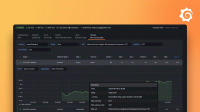Test for functional behavior
In this tutorial, learn how to write a test that does the following:
- Sends a POST request to the new endpoint
- Creates a check for the response status
Script the Request
The first thing to do is to add logic for the endpoint. To do that, you need to make an HTTP request:
- Import the HTTP module.
- Create a payload to authenticate the user.
- Use the
http.postmethod to send your request with the payload to an endpoint.
To test, copy this file and save it as api-test.js.
// import necessary module
import http from 'k6/http';
export default function () {
// define URL and payload
const url = 'https://quickpizza.grafana.com/api/users/token/login';
const payload = JSON.stringify({
username: 'default',
password: '12345678',
});
const params = {
headers: {
'Content-Type': 'application/json',
},
};
// send a post request and save response as a variable
const res = http.post(url, payload, params);
}Run the script using the k6 run command:
k6 run api-test.jsAfter the test finishes, k6 reports the default result summary.
/\ |‾‾| /‾‾/ /‾‾/
/\ / \ | |/ / / /
/ \/ \ | ( / ‾‾\
/ \ | |\ \ | (‾) |
/ __________ \ |__| \__\ \_____/ .io
execution: local
script: api-test.js
output: -
...As an optional step, you can log the response body to the console to make sure you’re getting the right response.
export default function () {
// ...
const res = http.post(url, payload, params);
// Log the request body
console.log(res.body);
}Add response checks
Once you’re sure the request is well-formed, add a check that validates whether the system responds with the expected status code.
- Update your script so it has the following check function.
// Import necessary modules
import { check } from 'k6';
import http from 'k6/http';
export default function () {
// define URL and payload
const url = 'https://quickpizza.grafana.com/api/users/token/login';
const payload = JSON.stringify({
username: 'default',
password: '12345678',
});
const params = {
headers: {
'Content-Type': 'application/json',
},
};
// send a post request and save response as a variable
const res = http.post(url, payload, params);
// check that response is 200
check(res, {
'response code was 200': (res) => res.status == 200,
});
}- Run the script again.
k6 run api-test.jsInspect the result output for your check. It should look something like this.
✓ response code was 200
Note
Under larger loads, this check will fail in some iterations. Failed checks do not stop tests.
Rather, k6 tracks the success rate and presents it in your end of test summary.
Next steps
In this tutorial, you’ve used k6 to make a POST request and check that it responds with a 200 status.
However, these tests make only one request, which doesn’t say much about how the system will respond under load. For that, you need to test under load.



